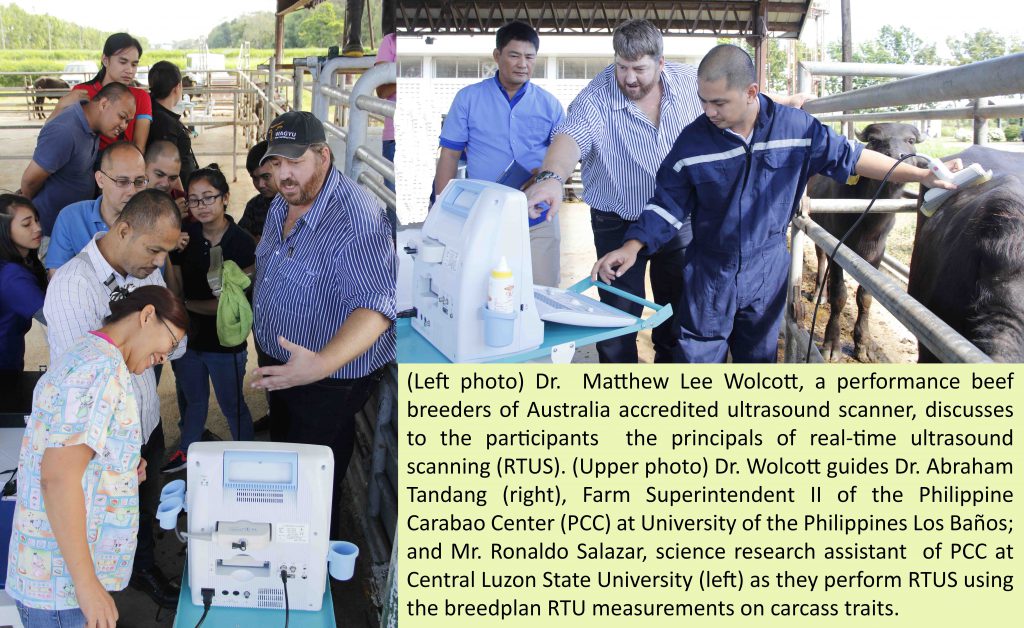“We can now avoid slaughtering potential breeder animals by evaluating their carcass trait through real-time ultrasound scanning,” Dr. Ester B. Flores, national genetic improvement program (GIP) coordinator and head of the Genomics and Bioinformatics Unit of the Philippine Carabao Center (PCC), announced this novel technology at the PCC GIP during a training on “Real-Time Ultrasound Scanning (RTUS) of Carcass Traits on Live Cattle and Buffaloes” held January 25-29 at the PCC National Headquarters and Gene Pool in the Science City of Muñoz, Nueva Ecija.
In the Philippines, breeding values for carcass trait cannot be directly estimated because the animal has to be slaughtered first before the “eye” muscle area can be determined. Therefore, for meat-type animals, breeding values are estimated based on growth traits of its half sibs and progenies which is a long and extractive process, according to Dr. Flores.
In other countries such as North and South America, Europe, Australia, Japan, and Korea, the RTUS has already been used routinely and extensively on beef cattle. Only this time and the first in the Philippines that this technology will be used on buffaloes.
Six PCC veterinarians and two research staff whose works are related to breeding and genetic improvement comprised the participants of this training.
“The select participants came from PC centers with the large herds that are most likely to do research on meat quality traits,” Dr. Flores said.
The training, organized by the Genomics and Bioinformatics Unit of PCC, aims to inform and familiarize participants on how to use the RTUS and analyze resulting data to determine potential breeder animals for growth, fertility, and carcass traits.
Dr. Flores said, this is another innovation in the selection of carabaos to increase productivity and improve the genetic potential of Philippine water buffaloes. She added that this is also an intervention to improve the quality of meat and milk.
“The increase in meat production efficiency and quality would hopefully translate to better incomes for thousands of buffalo raisers in the country,” Dr. Flores stated. She further said that only male buffaloes are scanned for fattening purposes while female buffaloes will only be scanned strictly for research and breeding purposes.
The training provided hands-on exercises on live animal ultrasound scanning of the eye muscle area, and pregnancy diagnosis.
Dr. Matthew Lee Wolcott, a visiting scientist at PCC from the Animal Genetics and Breeding Unit of the University of New England and performance beef breeders of Australia accredited ultrasound scanner, served as the resource person for the training. He provided a series of lectures on ultrasound scanning and actual demonstrations on scanning bovine species for carcass traits.
In the five-day training, Dr. Wolcott specifically discussed topics on scanned traits and trait definitions, RTUS measurement landmarks, accuracy of bovine body composition scanning, carcass yield estimation from live measurements, RTUS proficiency testing, breedplan and breedplan traits, breeding program design, necessity or appropriation of breedplan accreditation, and genetic evaluation of carcass traits in the Philippines.
During the hands-on exercises, the participants were grouped into three. Each group performed RTUS on more than 70 buffaloes using the breedplan RTU measurements on carcass traits such as P8 fat depth, P8 fat depth + hide, rib fat depth, rib fat depth + hide, and eye muscle area.
“This exercise aims to determine which bull grows faster and has more meat because some animals might grow very fast but might not necessarily have more carcass yield,” Dr. Flores explained.
The participants were evaluated based on the repeatability and accuracy of their scan results compared to the results obtained by Dr. Wolcott in the same procedure.

